1lumen selects and reviews products personally. We may earn affiliate commissions through our links, which help support our testing.
Fenix HT30R review: LEP flashlight test
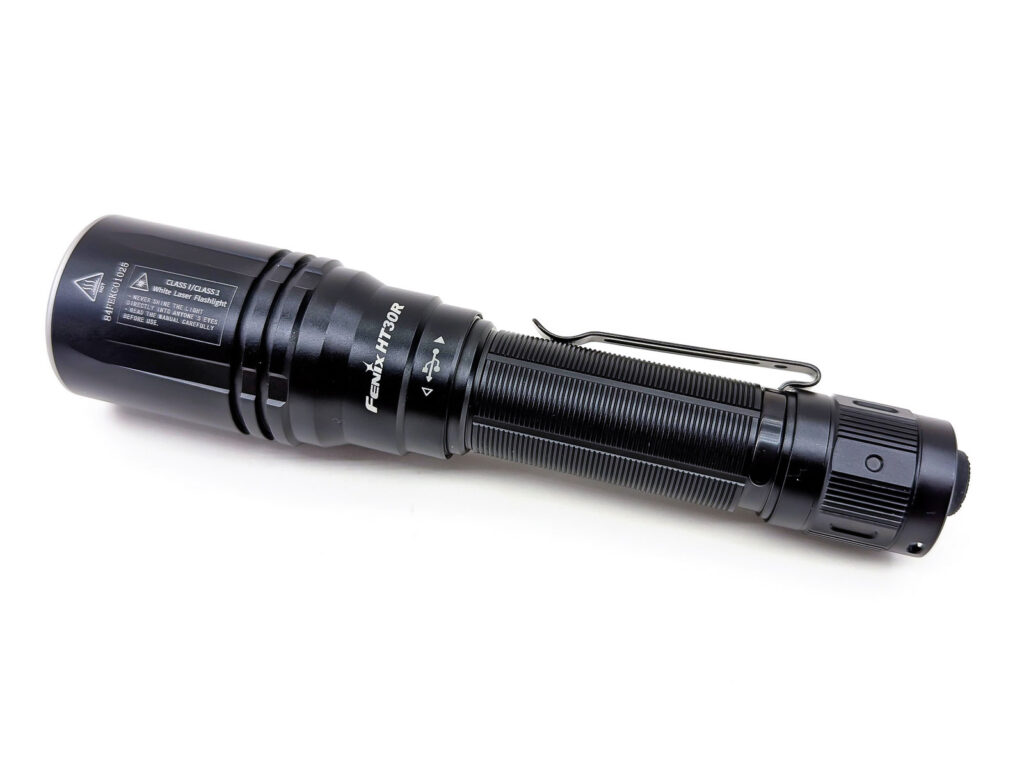
Fenix HT30R specifications
| Brand & Model | Fenix HT30R |
|---|---|
| LED | LEP |
| Max. output | 500 lumens |
| Max. beam intensity | 600,000 cd |
| Max. beam distance | 1,500 meters |
| Battery config. | 1*21700 |
| Onboard charging | USB-C |
| Modes | 2 |
| Blinkies | Strobe |
| Reflector | N/A |
| Waterproof | IP68 |
| Review publication date | Aug 2022 |
Introduction:
I’ve only owned a couple of LEPs before. The first was the Nextorch L10 Max, which was impressive even though it was in the “value” realm of the LEP world. I also had the chance to check out the Olight Valkyrie Turbo, which was a bit interesting though meant as a dedicated weapon-mount light. The Fenix HT30R is the first handheld LEP that I’ve used from what I would consider to be a well-established flashlight company. By and large, I really like Fenix – my first “real” flashlight was a Fenix (the 187 lumen E25 model, if you’re curious). I feel that Fenix puts out some very solid and quality products. So am I curious to see how a Fenix LEP can perform? You bet I am!
Spoiler, this is one of the best LEP flashlights you can currently get.
Package quality.
Fenix isn’t your budget-conscious brand. They don’t do cheap. So when they make a product, they put it in a fitting package. The Fenix HT30R arrived in a catchy black and orange box with an image of the flashlight, some design work, and of course the key specs. This box would be right at home on any store rack. Inside the carton was:
- Fenix HT30R
- Battery (21700, inserted)
- Charging cable
- Holster
- Lanyard
- Pocket clip (pre-installed)
- Spare o-rings
- Manual and other literature
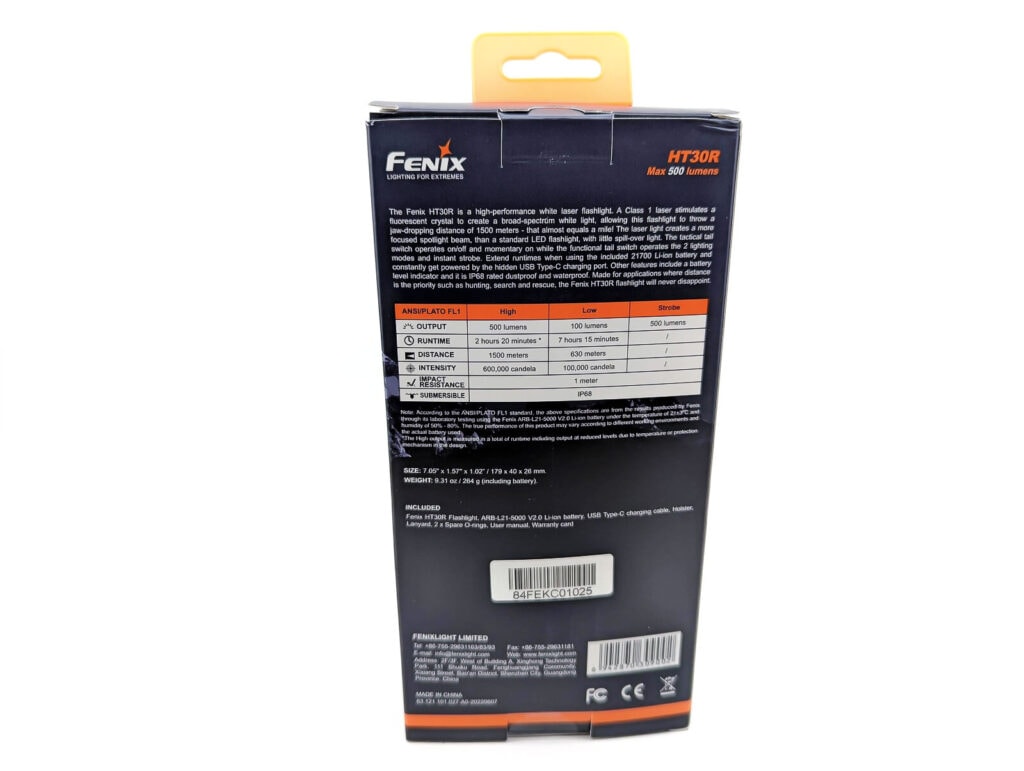
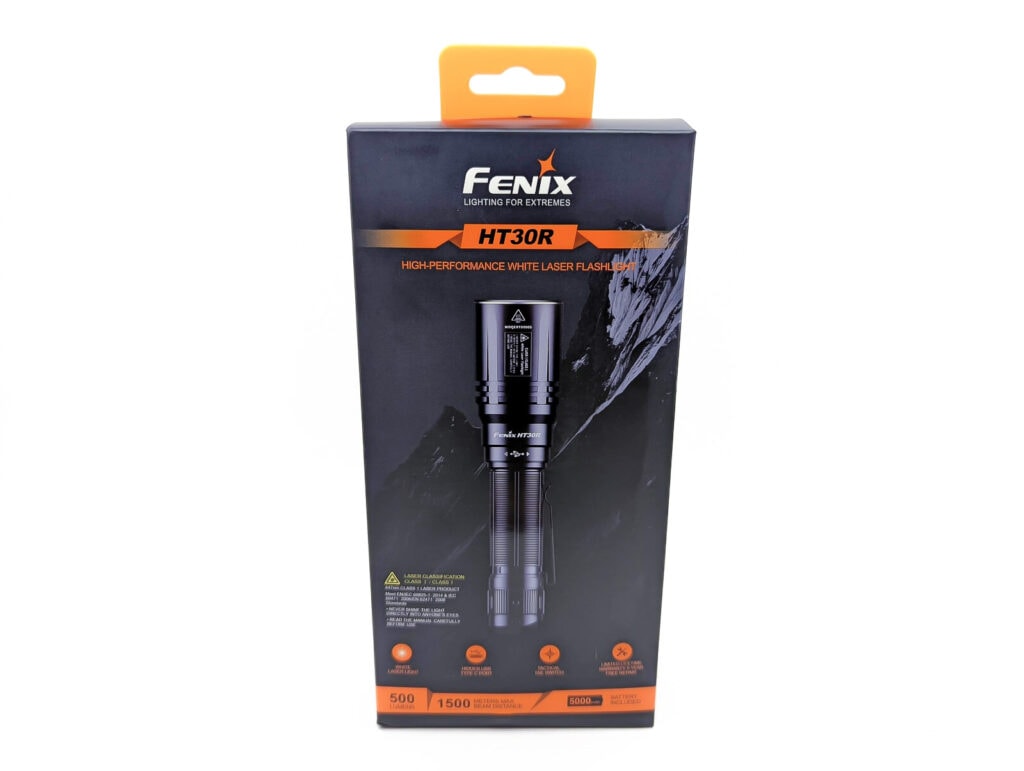
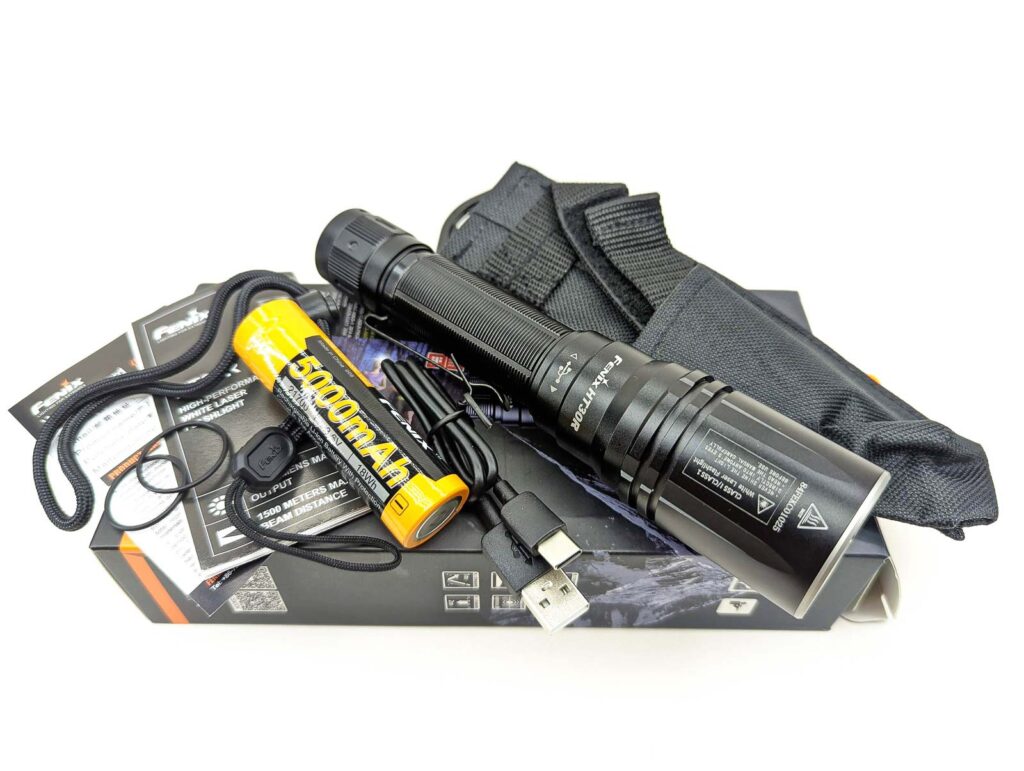
Flashlight in use
Size-wise, I consider the Fenix HT30R to be very comfortable to hold and operate. I feel like 21700 lights strike a nice, happy medium on sizes and overall sit in the hand pretty well even if they tend to be too big for EDC carry. The Fenix HT30R is long compared to your average LED-based flashlight, but this isn’t using an LED. It’s an LEP and LEP lights tend to be much longer to house the advanced optoelectronics.
In terms of carrying, the Fenix HT30R comes with a pocket clip preinstalled. The clip is very firmly attached and should work well, though I can’t see pocket-carrying the Fenix HT30R too often. Fenix included a lanyard that is a small step above your average flashlight lanyard – it is embossed with the Fenix logo and it has an adjustable bead for cinching the lanyard down. Lastly, Fenix also threw in a fabric holster for this LEP. The holster seems to work well and would probably be my preferred carry method if I wanted the HT30R with me frequently.
The Fenix HT30R has two switches, and both of them are on the tailcap. The main switch is a clicky on-off switch that also provides momentary activation. The second, less pronounced, button is an e-switch that is used for instant-Strobe and switching modes.
How or why does one use an LEP like the Fenix HT30R? That’s a good question. It’s a long-distance light that is suited to that above all else. I wouldn’t recommend reading a book or walking a dog with an LEP. But navigating a large body of water in the middle of the night? Yup. Finding that coyote running through your corn fields? Yup. Hailing a spaceship from the depths of outer space? Maybe.
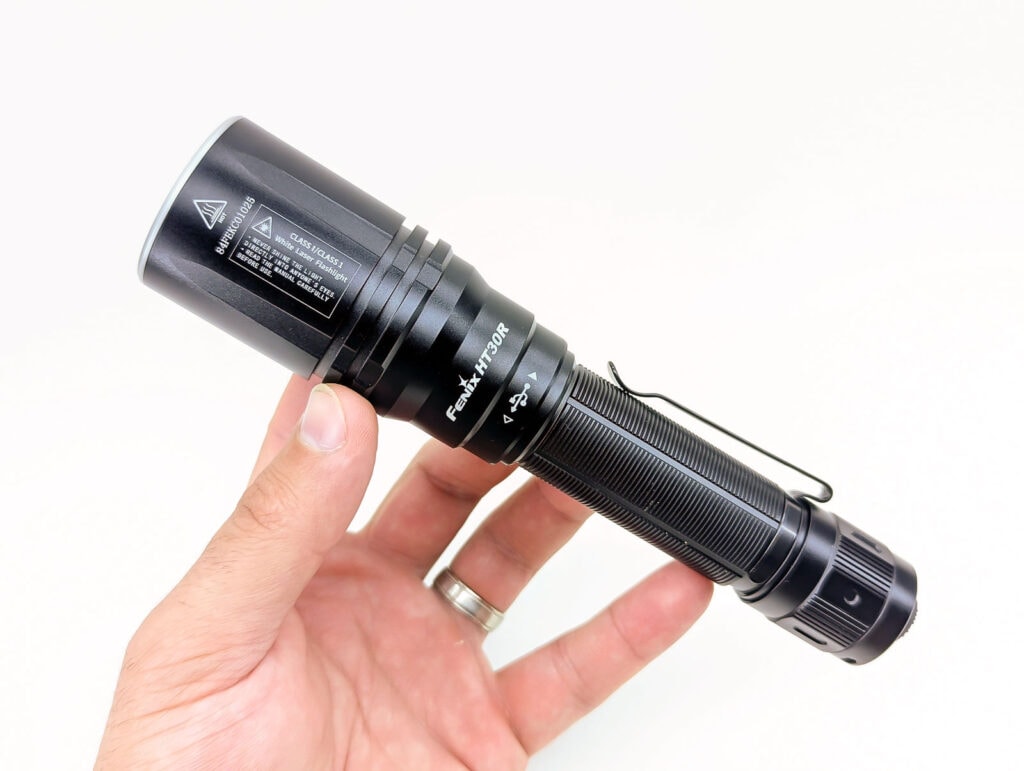

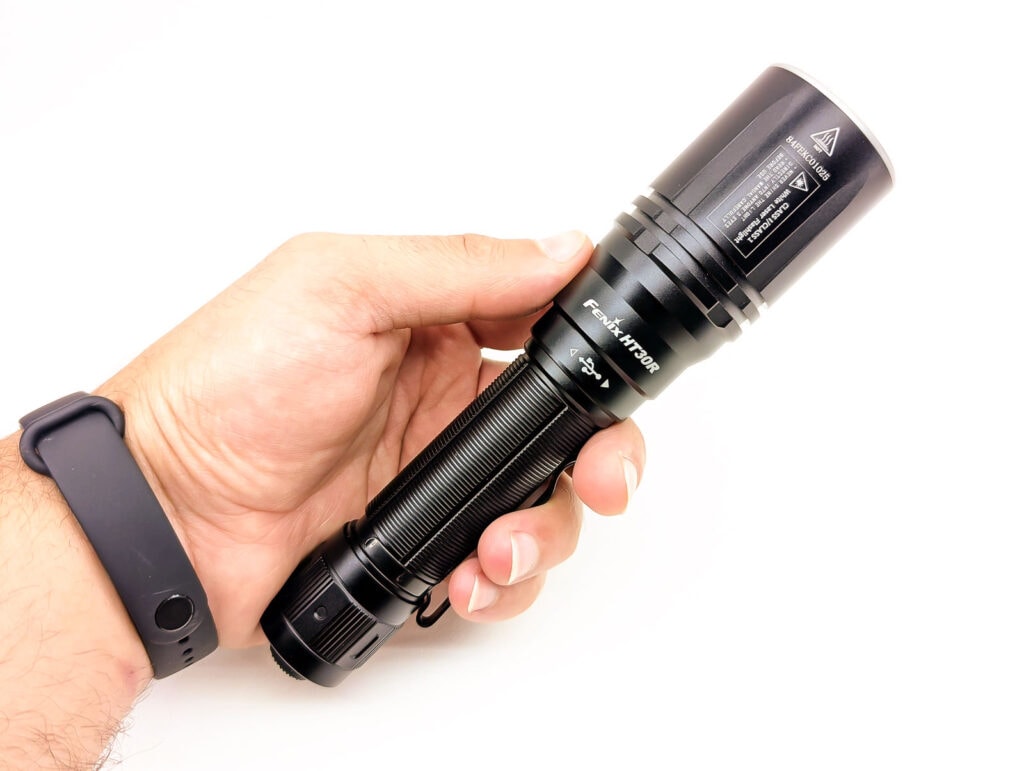
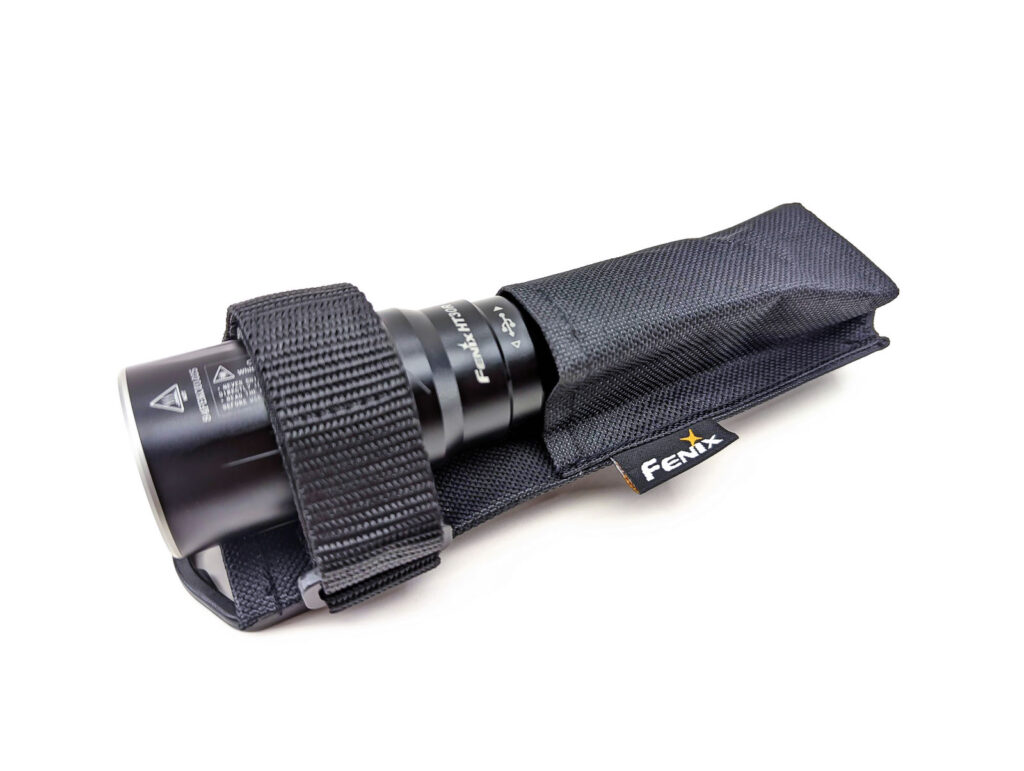
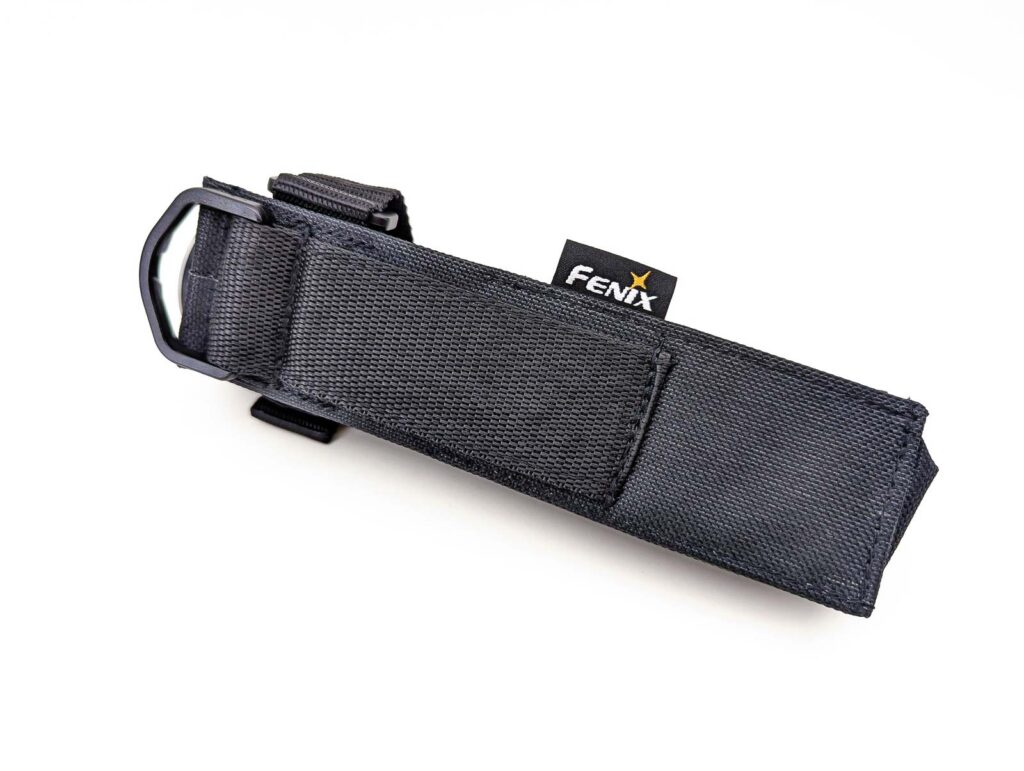
Build Quality, and Warranty
Quality? In my experience, Fenix doesn’t mess around. They used the typical A6061-T6 aluminum for the body and then gave it a good coating of HAIII anodizing. The finish is really well done. It’s a bit on the shiny side. The battery tube is covered in grooves that form rings down its length. These provide a little bit of traction but not a ton.
I would say that the Fenix HT30R doesn’t just feel like a flashlight – it feels like I’m holding a professional tool when I have it in my hand. Part of that is because it is a professional-grade tool. It also speaks to Fenix’s attention to detail and build quality. Everything seems really well executed.
Warranty:
- 15 days from date of purchase: replacement from Fenix for manufacturing defects
- 5 year from date of purchase: free repairs
- Lifetime maintenance, with customer covering the cost of parts
- Extra 6 months warranty period for products registered on Fenix’s website
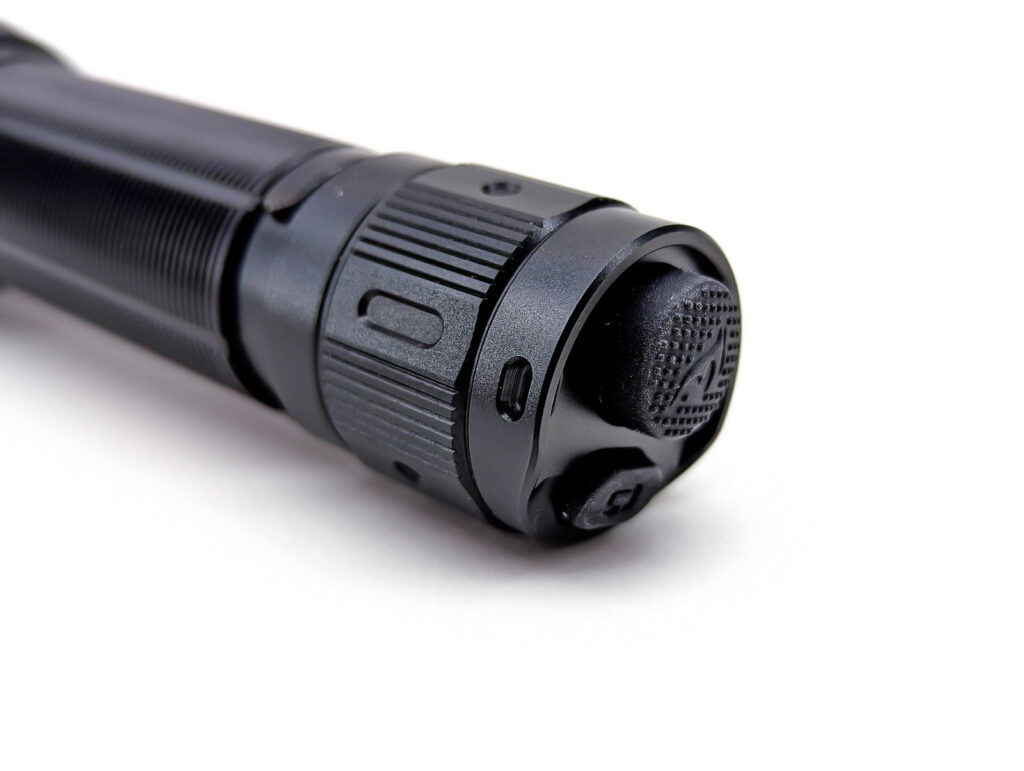
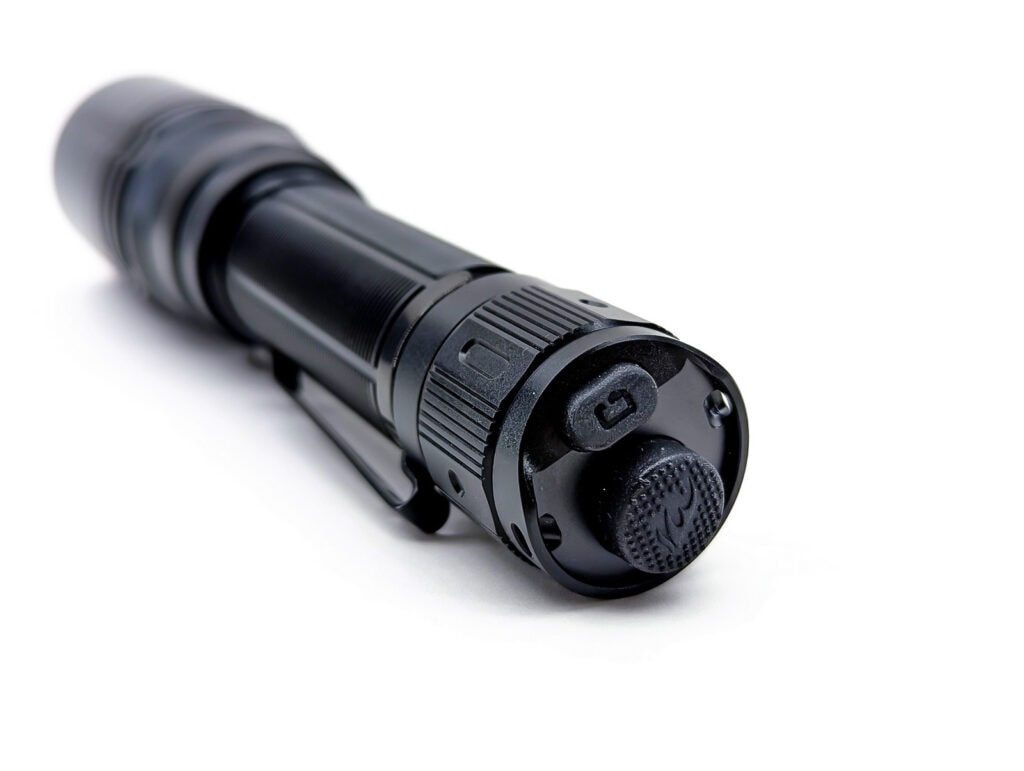
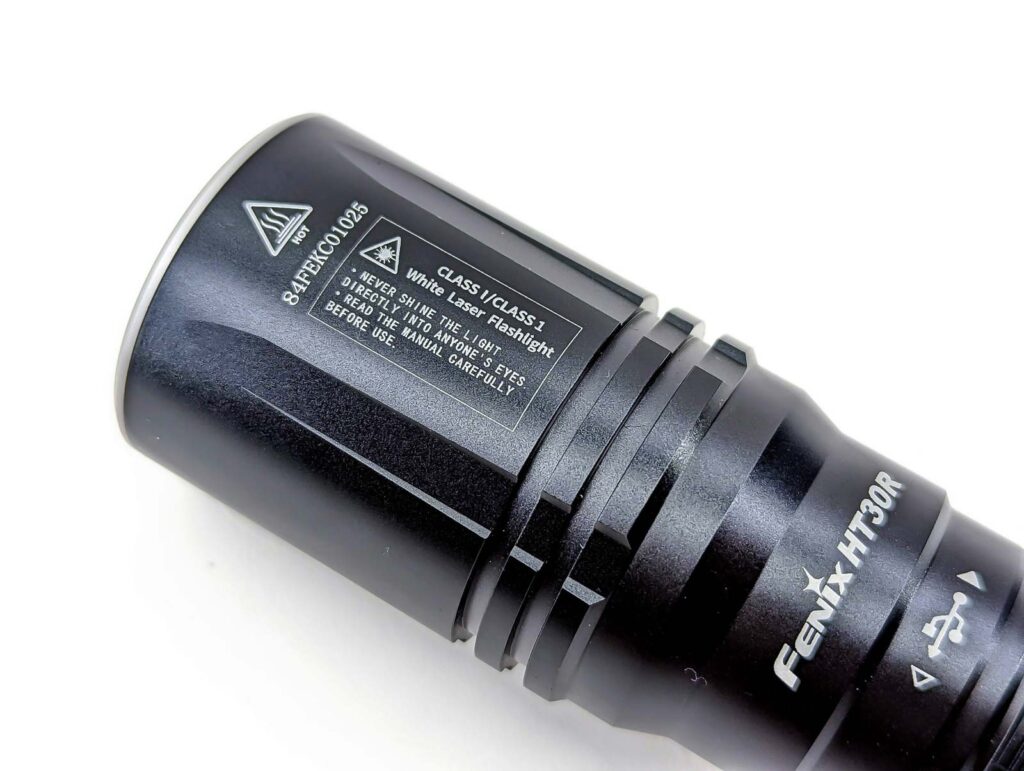
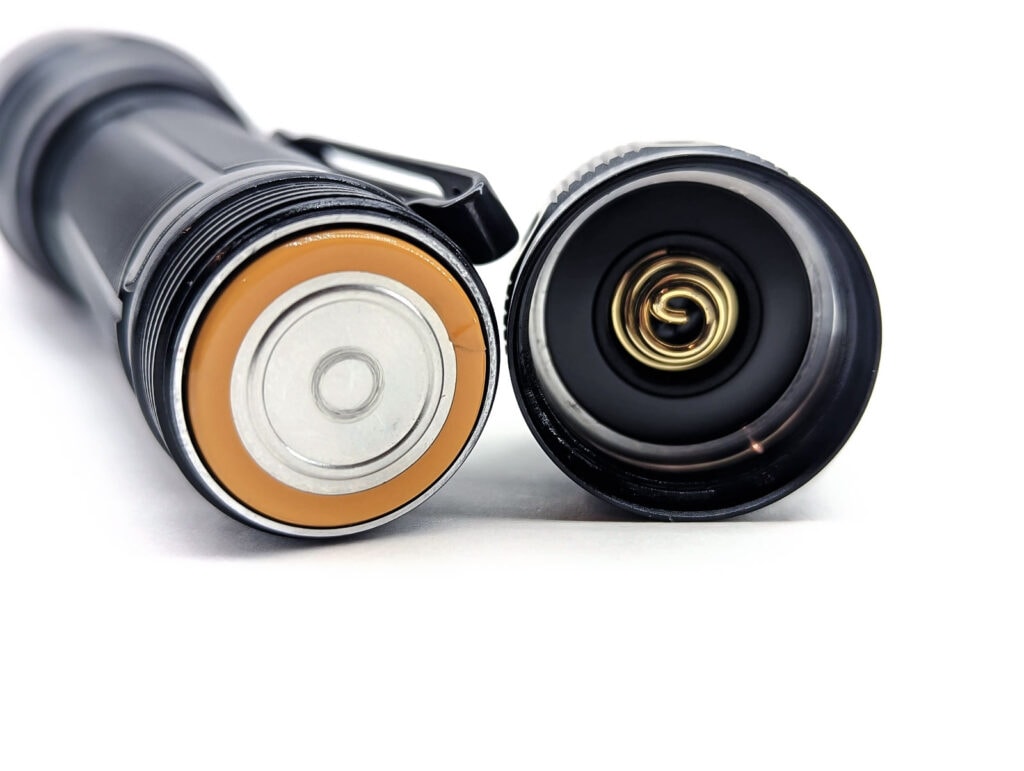
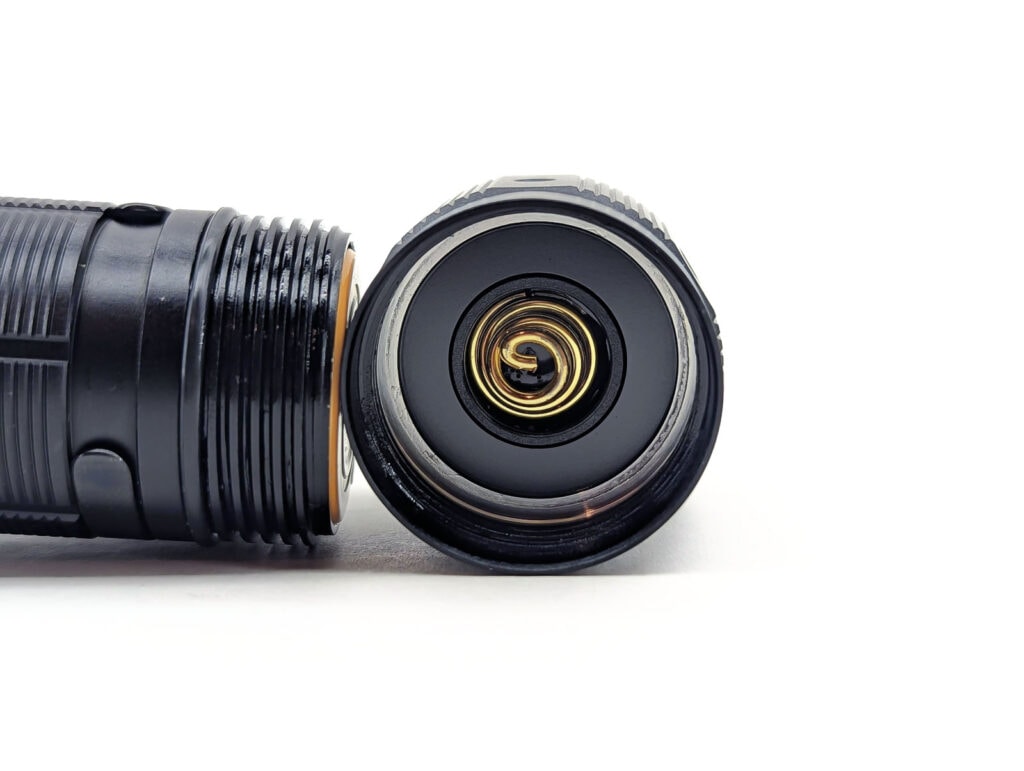
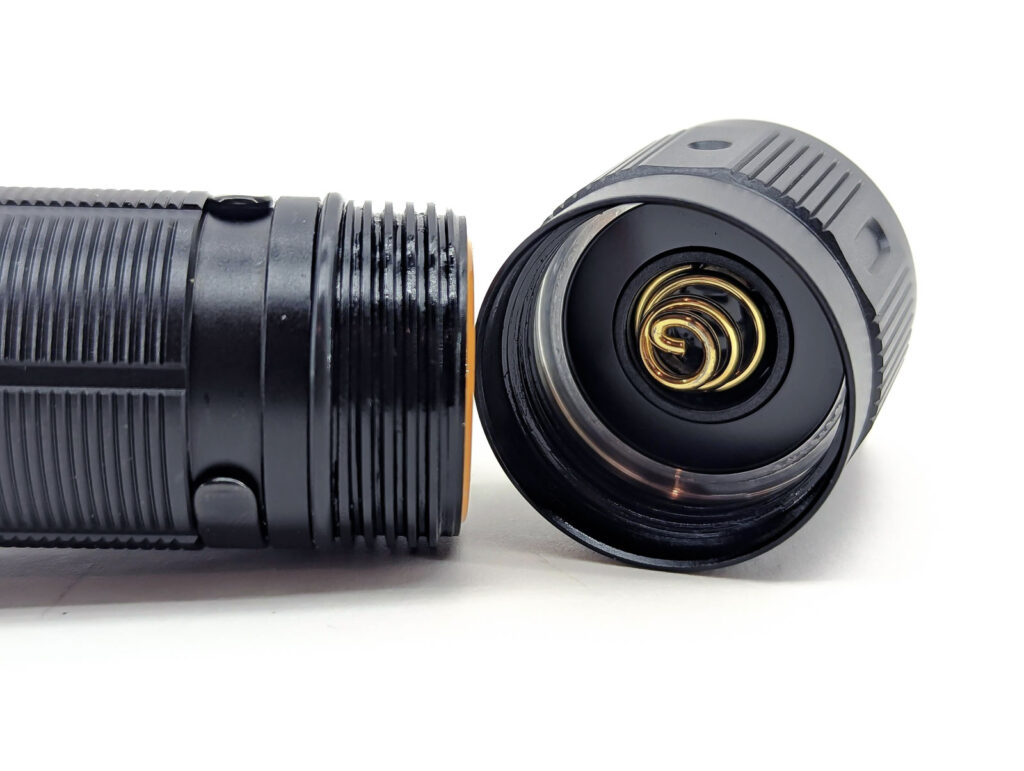
LEP, Lens, Bezel, Beam, and Reflector
You probably realize this by now, but the Fenix HT30R isn’t your average flashlight. Instead of an LED or multiple LEDs, the HT30R uses a laser. According to Fenix, it’s a “447nm Class 1 white laser” to be more specific. They also say it uses a “10W High Performance laser module” with a CCT of 6500K.
The bezel of the light is a smooth, matte stainless steel ring. Inside the bezel is what appears to be an anti-reflective coated piece of protective glass. Underneath that is a convex lens that helps focus the beam.
Measurements from the Opple Light Meter at 10 meters in High mode:
- CCT: 8174K
- CRI: 71.8 Ra
- DUV: -0.0006
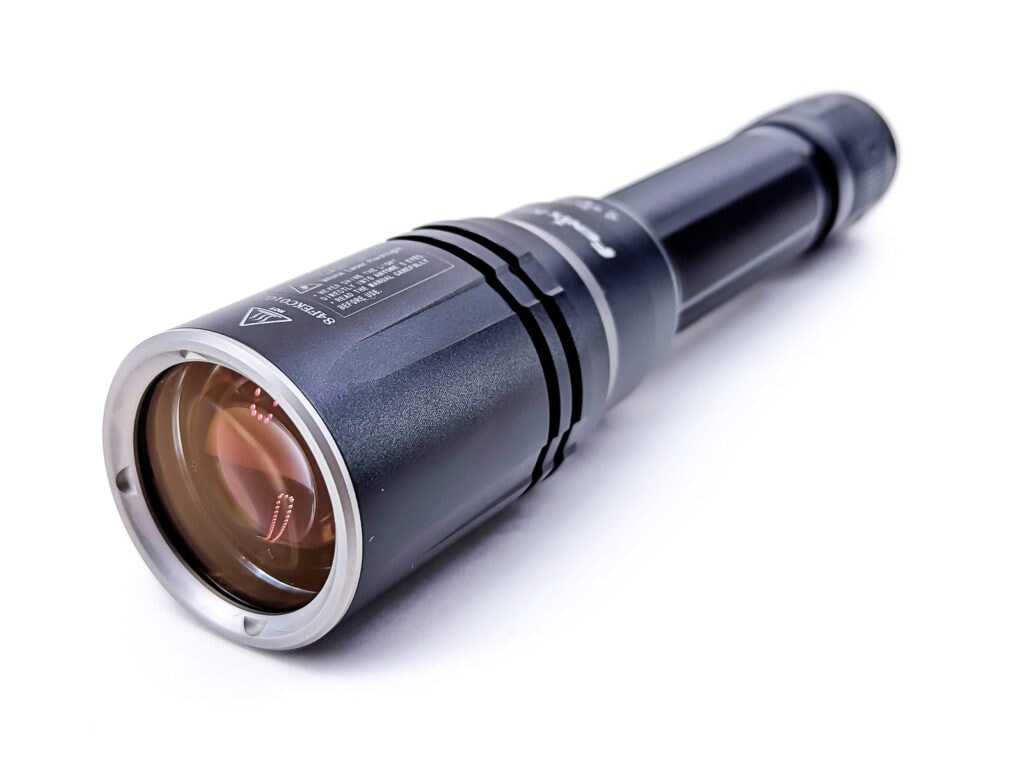
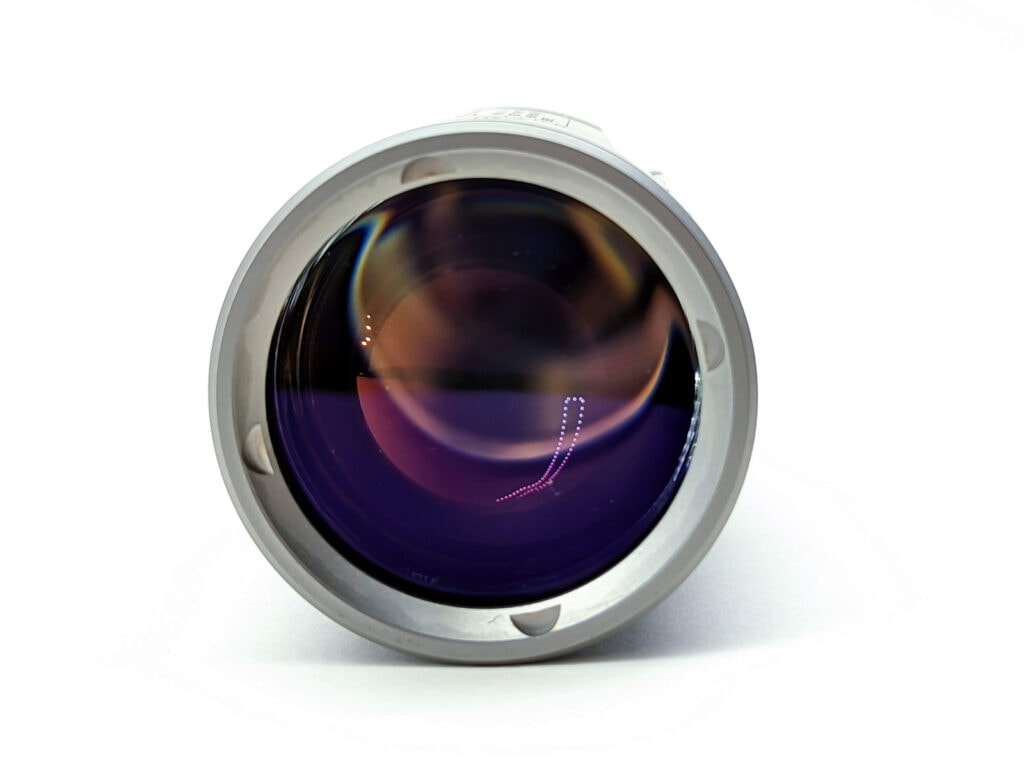
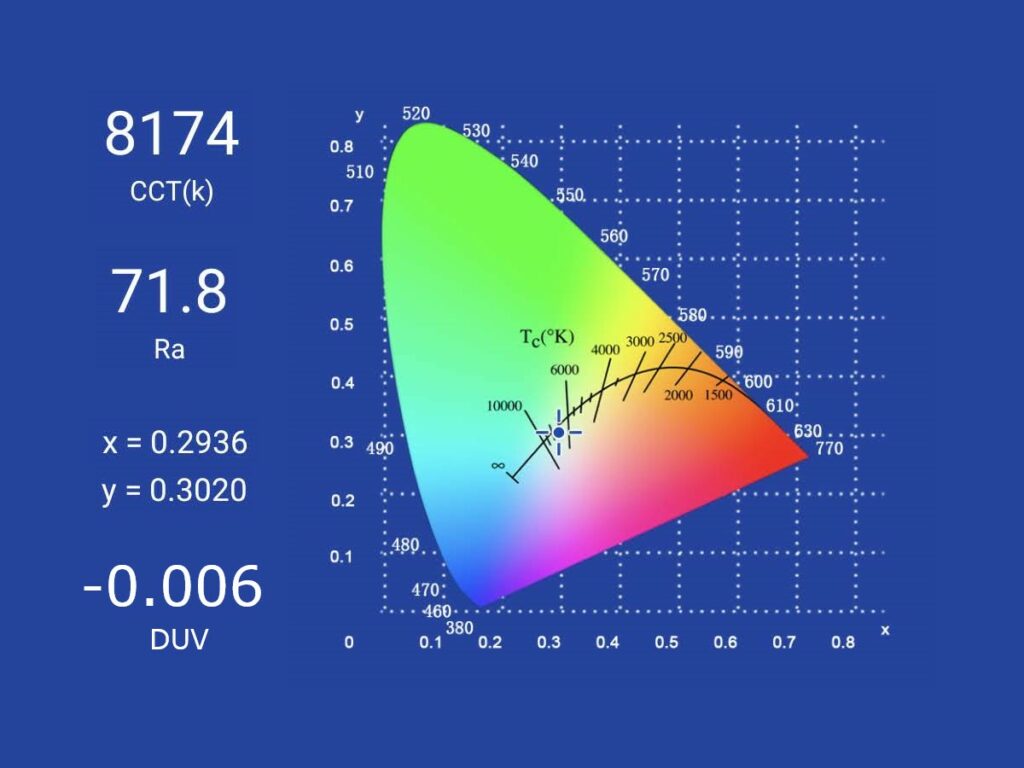
Dimensions and size comparison
Dimensions:
| Dimension | Millimeters | Inches |
|---|---|---|
| Length | 179 | 7.05 |
| Head diameter | 40 | 1.57 |
| Body diameter | 26 | 1.02 |
Weight:
| Weight | Grams | Oz. |
|---|---|---|
| Without battery: | 191 | 6.74 |
| With battery | 264 | 9.31 |
Flashlight size comparison with its competition
Group 1 LEP flashlights: Fenix HT30R, Nextorch L10 Max
Group 2: Convoy L7, Mateminco MT35 Mini (aka Astrolux FT03S), NlightD T90, Fenix HT30R
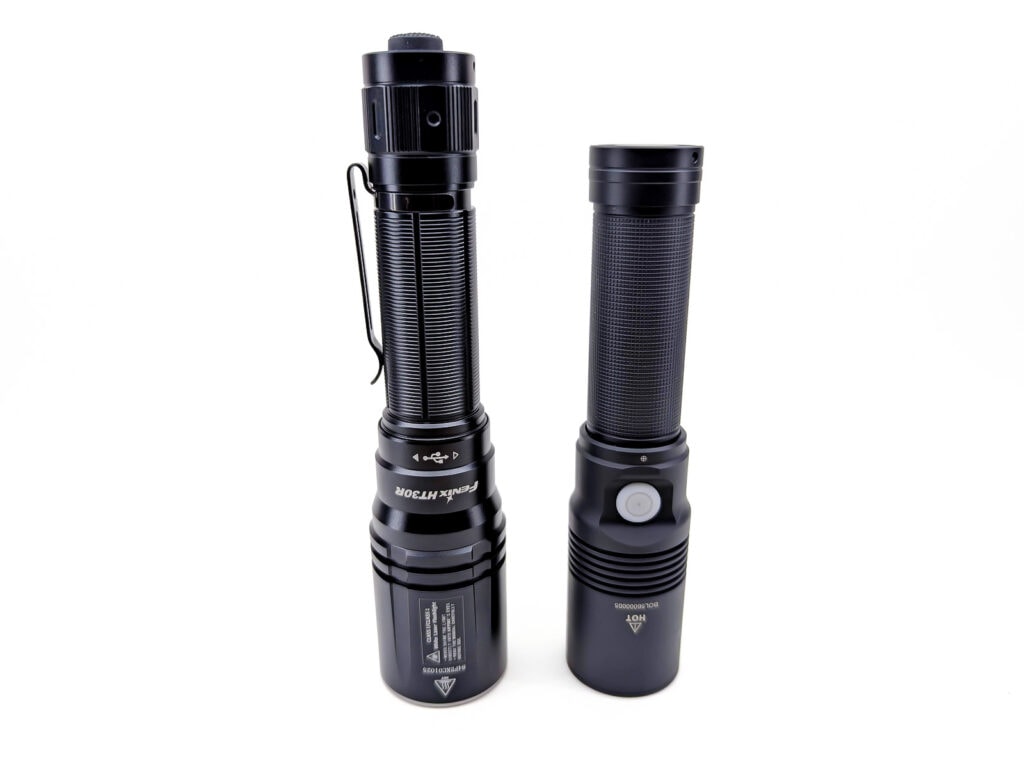
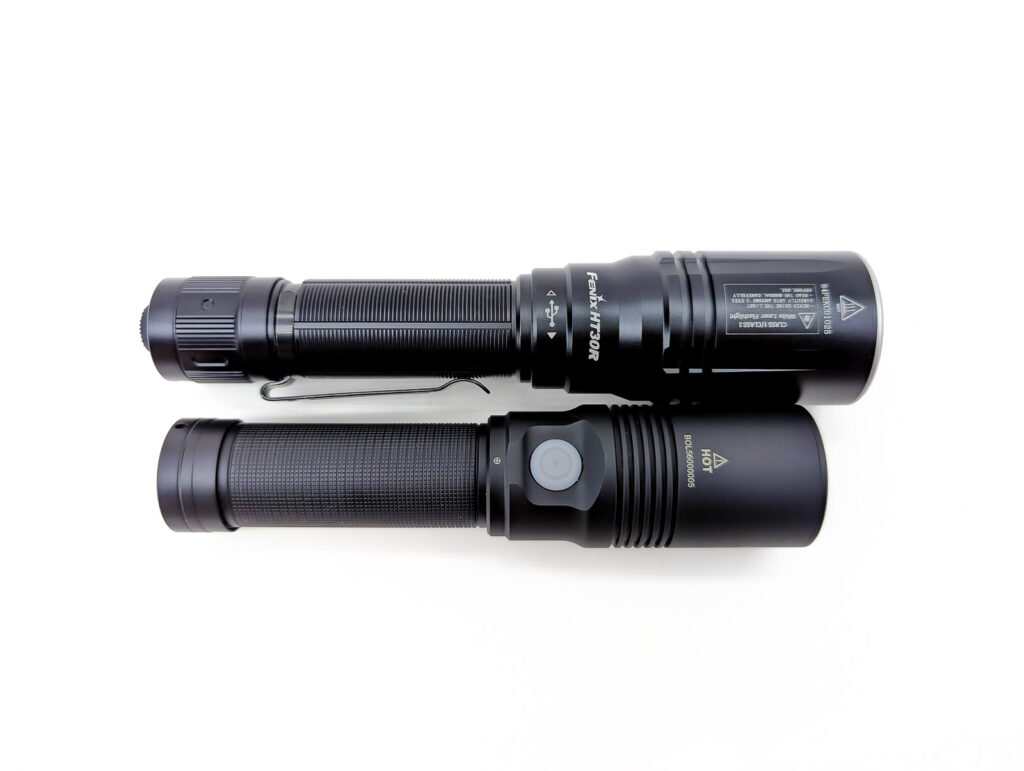
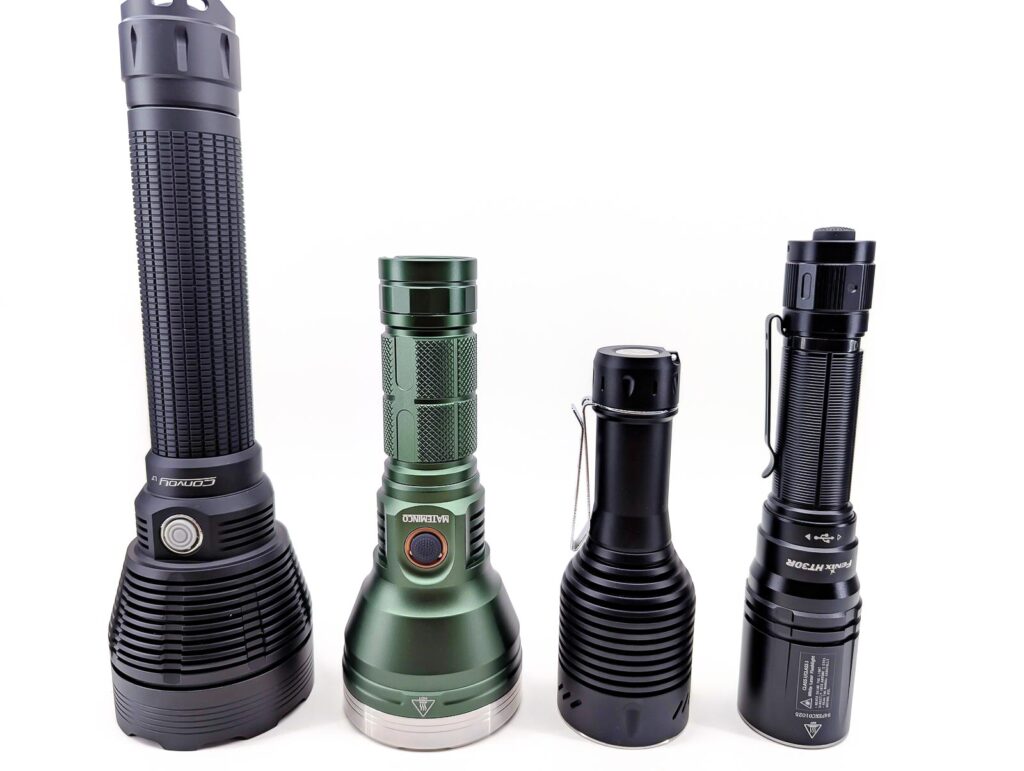
Driver & User Interface:
The UI of the Fenix HT30R is refreshingly simple, which is also fitting for an LEP. It uses two buttons, both of which are on the tailcap. The main button, which Fenix calls the “Tactical Switch”, is a forward-clicky that is responsible for on-off. The other button, which Fenix calls the “Functional Switch”, is a smaller, less pronounced e-switch that is used for “instant strobe” and for mode switching.
Available modes: High, Low
Available blinky modes: Strobe
User interface:
From OFF:
- Tactical Switch, half-press and hold: momentary on
- Tactical Switch, single click: turn on
- Functional Switch, press and hold: momentary strobe
From ON:
- Tactical Switch, single click: turn off
- Functional Switch, press and hold: strobe
- Functional Switch, single click: switch modes
Mode memory:
- Yes, it will remember Low vs High but not Strobe
Shortcuts:
- To momentary Strobe: press and hold the Functional Switch from Off
- To constant Strobe: press and hold the Functional Switch from On
Low voltage warning:
- After stepping down, the light will blink every 5 minutes until it shuts off
- If you unscrew the neck of the light (how you would expose the USB-C port), an indicator LED is visible. When you turn the switch on, the LED will flash either green (100-30% remaining) or red (30-1% remaining).
Strobe/blinkies
- Yes, there is both a constant strobe and a momentary strobe
- From Off, press and hold the Functional Switch to enable momentary strobe
- From On, press and hold the Functional Switch to enable constant strobe
Lock-out mode:
- There is no electronic lockout, but you can physically lock it out by twisting the tailcap
PWM
- There is no PWM
Additional info on the UI:
- N/A
Batteries & Charging
The Fenix HT30R takes 21700 batteries, or in a pinch, you can use 18650s with Fenix’s ALF-18 battery holder. The light arrived with a Fenix ARB-L21-5000 V2 5000mAh 21700 battery inside of it, isolated with a little plastic protective disc. It arrived at 3.58V The included battery is a protected button-top cell. I tried a flat-top non-protected cell in it, a Molicel P42A. Despite the Fenix HT30R having springs at both ends, the Molicel was too short for the light to operate.
The kit includes a USB-A to USB-C charging cable. In order to plug in the cable, you need to unscrew the neck of the light, almost like you’re using a zoomie light. But instead of changing the focal length, unscrewing the neck reveals a USB-C port and an indicator LED, both of which are normally sealed off with an o-ring that becomes visible when you unscrew the neck.
Side note, you cannot turn the light on with the neck unscrewed.
Fenix says the HT30R should fully charge the 5000 mAh battery (from empty) in 3 hours. In my testing, I saw a 2.9 amp charge rate at 5 volts (14.7 watts). The charge cycle was completed in 3 hours and 3 minutes with a final battery charge of 4.15 volts.
Note by Marco: during charging, you can see a solid red light, 45 degrees from the charge port. If the red light is blinking, the battery is NOT charging. My finally battery voltage was 4.14V.
Note by Marco: I noticed that during a runtime test, the battery’s protection kicked in, and read 0V. It was not possible to start the charge. I had to revive the battery (unlock the protection) by briefly adding it to a normal charge. A battery with the protection activated normally reads 0V. That’s just the protection that kicked in.
So, even if you don’t want to buy a separate charger, I do recommend looking at our best 21700 battery charger list, for backup.
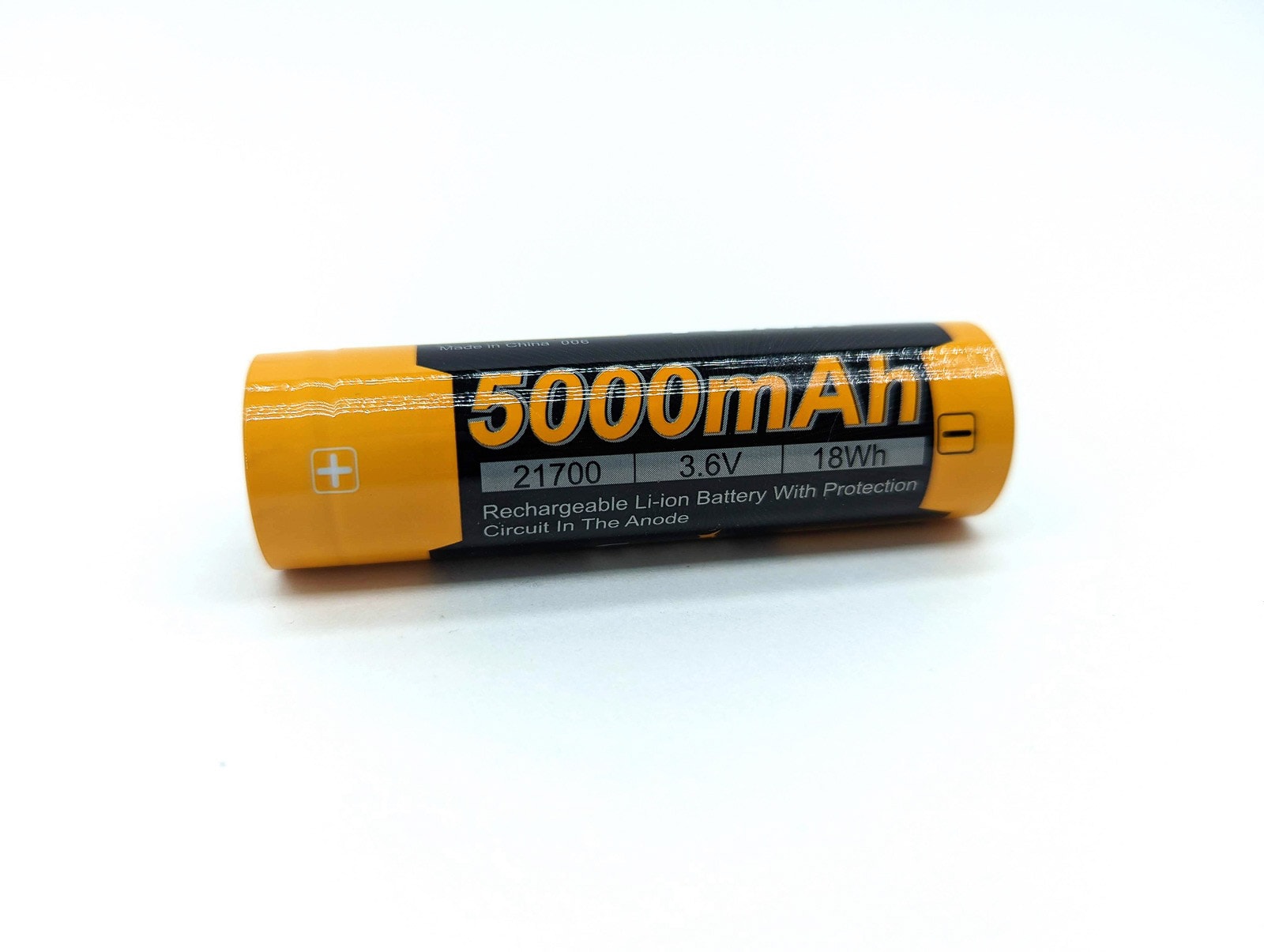
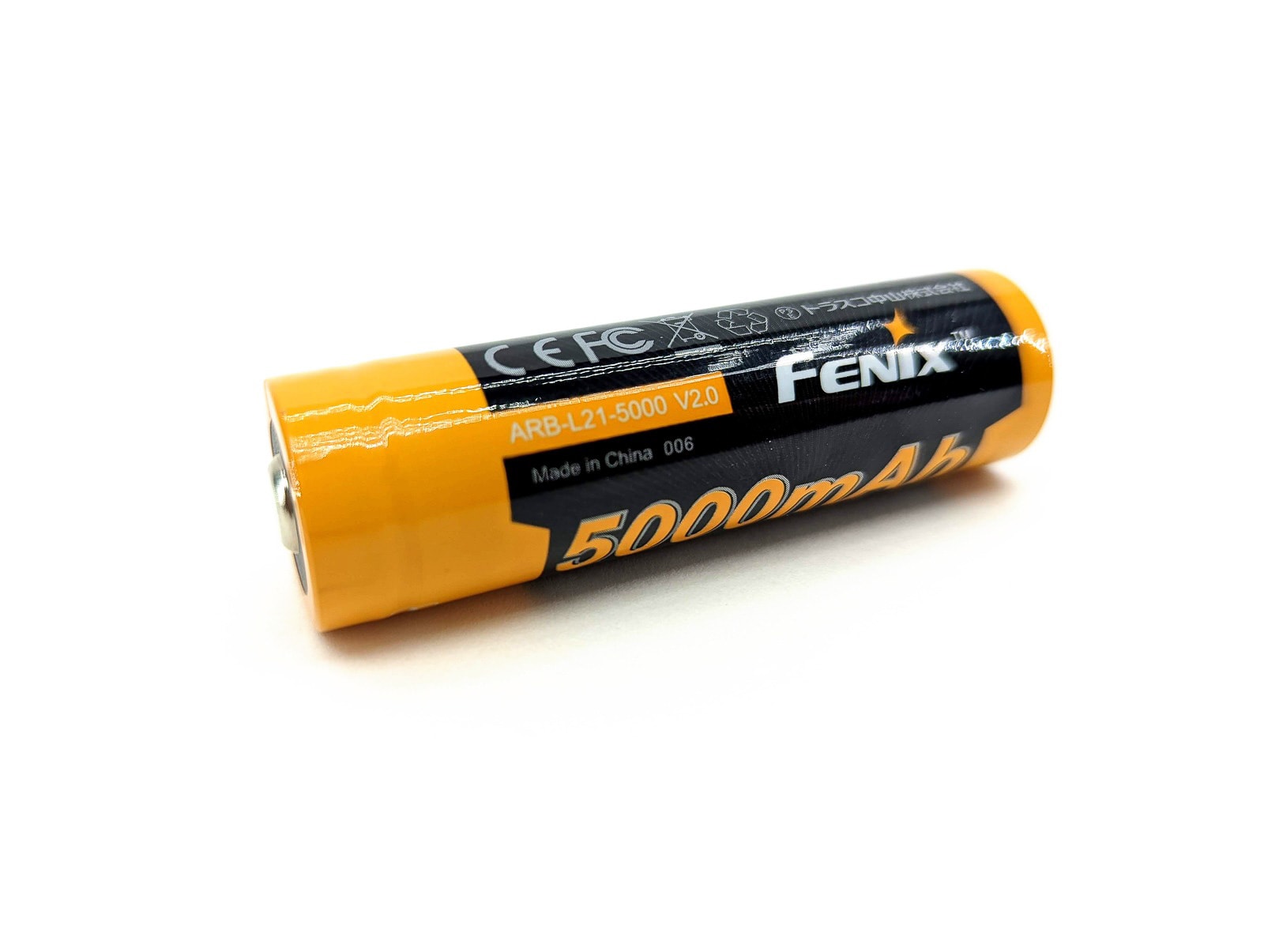
Performance test
Lux was measured by a UNI-T UT383 BT at 10 meters. Lumens were measured in a homemade lumen tube using a TSL2591 sensor, calibrated with a Maukka calibration light. The temperature was monitored with a MLX90614 IR temperature sensor. The included Fenix battery was used for testing.
Lumen measurements
Note: because of the tailcap design, I was not able to measure amps. Honestly, I’m not entirely sure how the tailcap works. It has two switches in it, but there is only one path for current – the main battery tube. It’s not a dual-tube design, nor does the battery have a negative contact at the positive pole. And you don’t need to do anything with the tailcap in order to get charging to work. That all makes me really curious, but I’m not about to take it apart and appease my scientific curiosity while working on this review.
| Mode | Specs | turn on | 30 sec | 10 minutes |
|---|---|---|---|---|
| Low | 100 lm | 100 | 96 | 91 |
| High | 500 lm | 442 lm | 422 lm | 329 lm |
Edit: 2023-05 Retested with Marco’s unit.
I (Marco) tested my copy as well, and here are the measurements. They are different from Gabriel’s measurements but not far off. Mine is not the same unit as Gabriel’s.
| Mode | Specs | turn on | 30 sec |
|---|---|---|---|
| Low | 100 lm | 109 lm | 106 lm |
| High | 500 lm | 490 lm | 474 lm |
Parasitic drain:
- ?
From what I am able to measure, I’m not seeing the 500 lumens that Fenix claims. I do find that a bit odd, as I generally have a lot of faith in Fenix’s specs. While I don’t want to give them a free pass if it really is not meeting the spec, I don’t think anyone buys an LEP for the lumen output. LEPs are all about those candelas! So as long as it meets the throw claim (keep reading) then I won’t be too disappointed.
The output in High mode ramped down very slowly over the first 15 minutes before settling into its consistent output level (around 265 lumens).
Battery Life: Runtime graphs
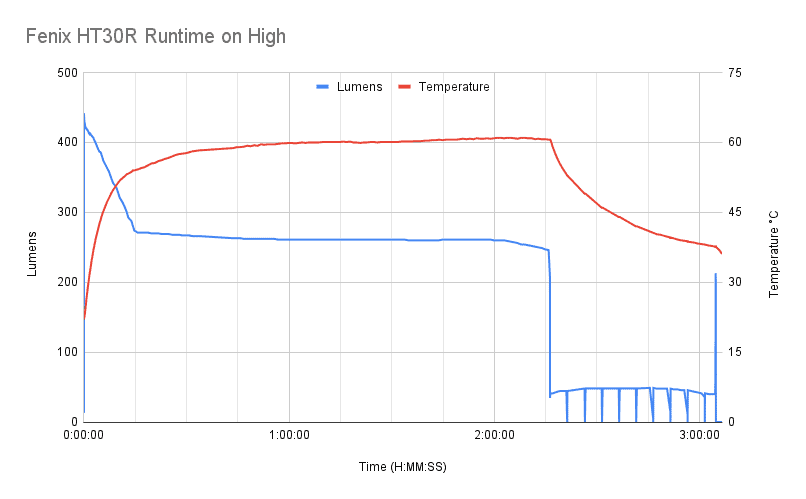
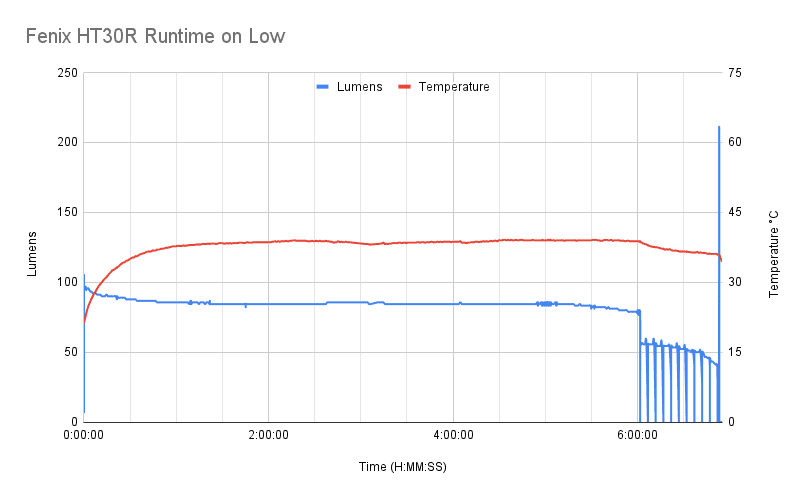
| Mode | Specified | Measured runtime (ANSI) | Time till shut off |
|---|---|---|---|
| Low | 7 hr 15 min | 6 hr 53 min | 6 hr 53 min |
| High | 2 hr 20 min | 2 hr 16 min | 3 hr 5 min |
I’m not exactly sure if the ANSI FL1 standard would end a runtime if a quick low-battery blink goes under the 10% level. I didn’t count that, as the flashlight was still running at a higher level and those were just really quick blinks. The first low-voltage blink occurred at 6 hr 1 min.
ANSI FL1 standards: The runtime is measured until the light drops to 10% of its initial output (30 seconds after turning on). This does not mean that the flashlight is not usable anymore. The last column shows how long the light actually works till it shuts off. If there is a + symbol, it means that the test was stopped at that particular point, but the light was actually still running. This happens on certain occasions, with certain drivers, firmware, or batteries.
Peak beam intensity and beam distance measurements
Throw was tested at 20 meters after 30 seconds with my UNI-T UT383 BT
| Mode | Specs | Candela measured | Meters | Yards |
|---|---|---|---|---|
| Low | 100,000 cd | 160,000 | 800 m | 875 |
| High | 600,000 cd | 650,000 cd | 1612 mm | 1763 yd |
Despite the lumens measuring low, the throw measurement exceeded spec! And that’s what we’re really looking for in an LEP.
Edit: Marco also tested his copy and got the following numbers:
| Mode | Specs | Measured | Meters | Yards |
|---|---|---|---|---|
| Low | 100,000 cd | 169,200 cd | 823 m | 900 yd |
| High | 600,000 cd | 700,000 cd | 1673 m | 1830 yd |
I used the Hagner E4-X lux meter and measured at 20 meters distance, after 30 seconds.
Extra info: Peak beam distance according to ANSI FL1 standards: The calculated value of distance in meters at which the flashlight produces a light intensity of 0.25 lux. (0.25 lux is about the brightness of a full moon shining on an object).
Beamshots
The farm shed in these beamshots is 100 meters (109 yards) away. Pictures were taken with my Pixel 6 using ƒ/1.9, ⅕ second exposure time, and ISO200. The tree was 250 meters (273 yards) away, I switched to a 1-second exposure (still at ISO200) for that shot.
Beamshots compared to the following flashlights:
- Fenix HT30R
- Nextorch L10 Max
- Convoy L7
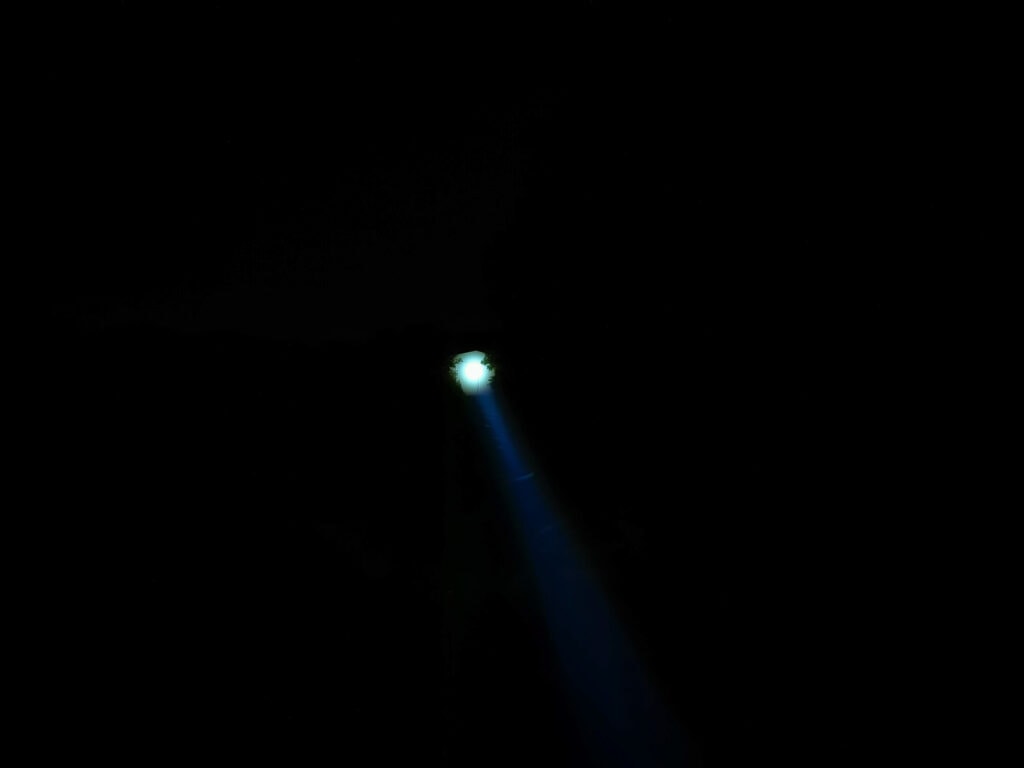
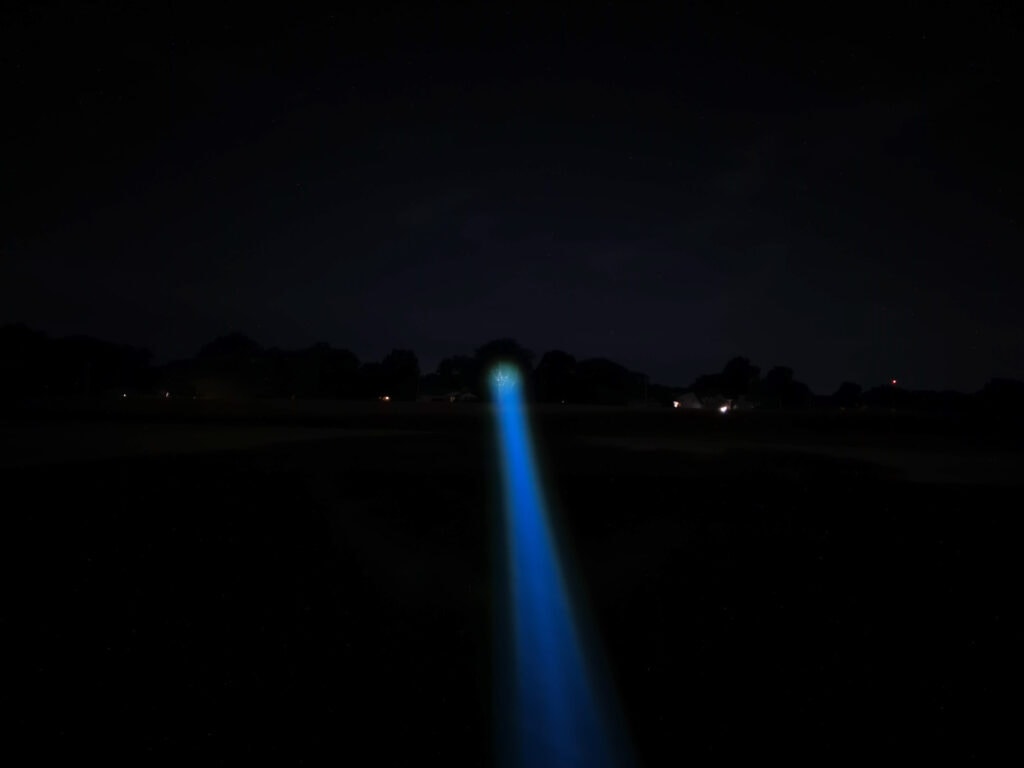
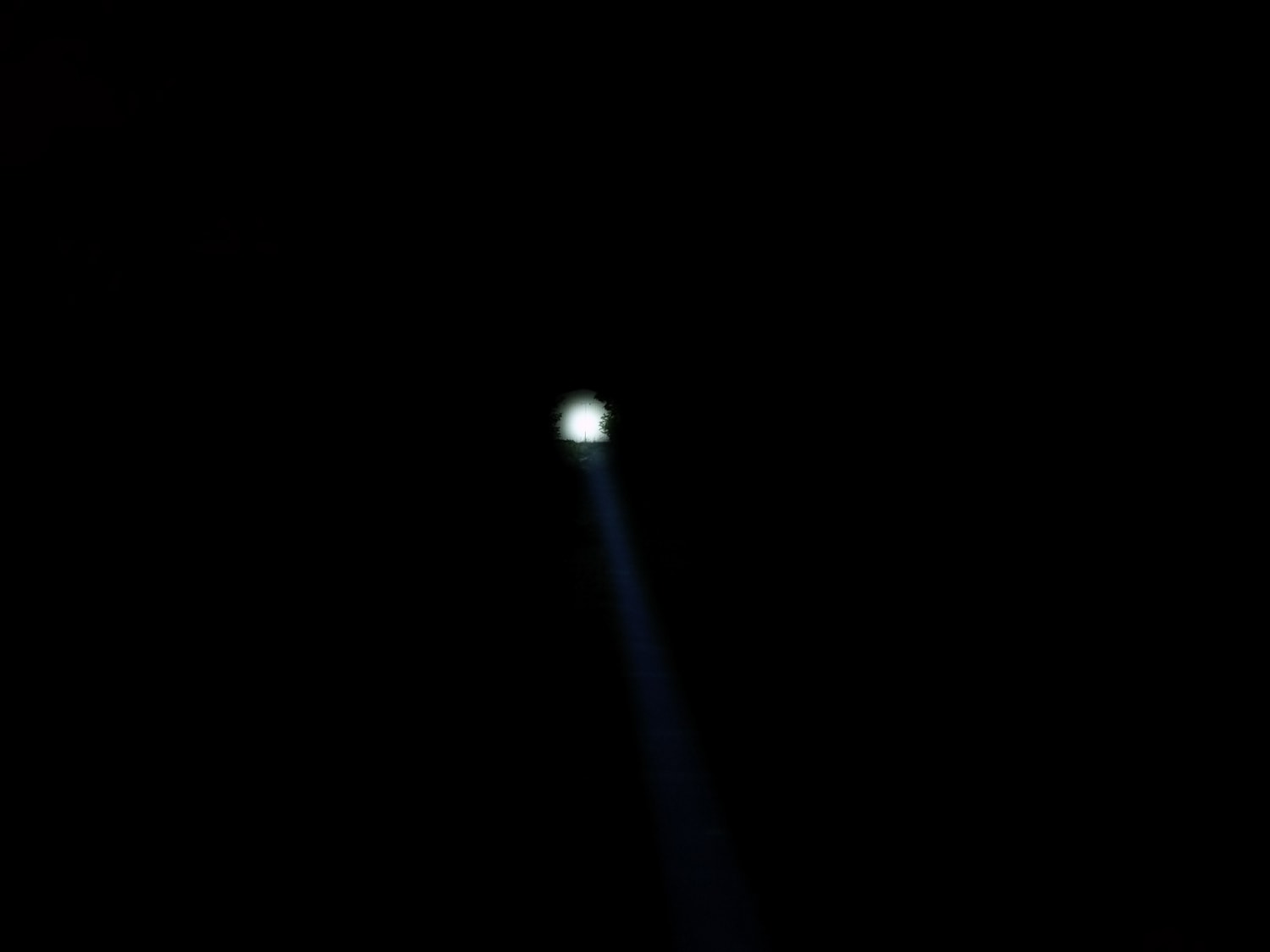
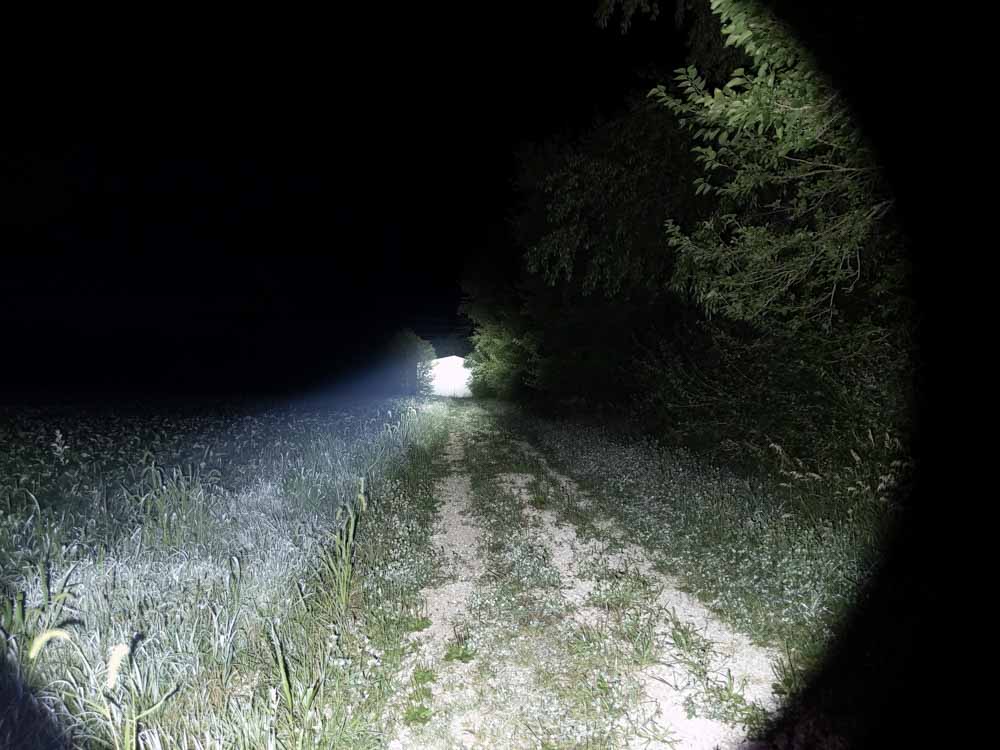
Disclaimer: This flashlight was sent to me for review at no cost by Fenix Lighting US. I have not been paid to review, nor have I been holding back on problems or defects.
Final Verdict
Pros
- Excellent build quality
- Throws farther than spec
- Good regulation
- No abrupt step-downs
- Hidden / protected USB-C charging
- Really simple UI
Cons
- Seems to miss lumen spec
- Needs long (eg, protected) cells
Explanation on star ratings:
1: Avoid: my phone flashlight would be a better choice – 2: Poor: significant defect or issues; almost unusable – 3: Average: some defects or issues; but still usable 4: Good: recommended (minor issues) – 5: Great: highly recommended

5 stars: ★★★★★
Fenix really knows how to make a great light. The Fenix HT30R has such a nice build quality, you can tell it was made to be an actual tool – not just a run-of-the-mill flashlight. It’s hard for me to find much fault with it, aside from seemingly lower lumen output than spec and requiring long/protected batteries. In my throw test, it calculated to just over a mile of throw which is very impressive to see in person. The Fenix HT30R gets two thumbs up!
Buy your Fenix HT30R with our discount code
Get 10% off every purchase at Fenix Lighting US, by using our exclusive 1lumen discount code: 1lumen10
1lumen selects and reviews products personally. We may earn affiliate commissions through our links, which help support our testing.